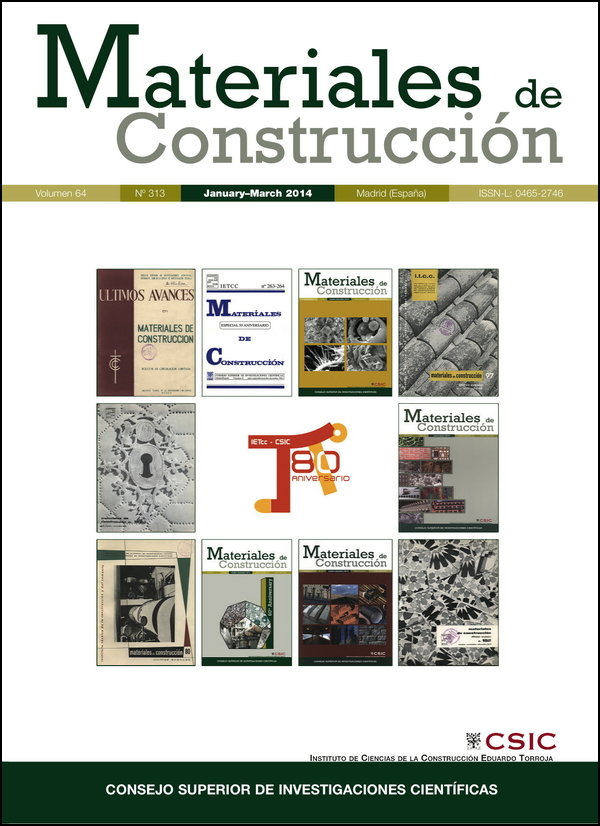Fracture energy evolution of two concretes resistant to the action of freeze-thaw cycles
DOI:
https://doi.org/10.3989/mc.2014.00813Keywords:
Concrete, Freezing-thawing, Air-entraining additive, Silica fumeAbstract
The current standards that regulate use of structural concrete have highlighted the durability of concrete. However, how the fracture energy of concrete evolves under the action of freeze-thaw cycles is not well known. The fracture energy of two types of concrete, one with an air-entraining additive and the other with silica fume addition, is studied after four, 14 and 28 freeze-thaw cycles. The results obtained show that the concrete with an air-entraining additive was undamaged and that fracture energy grew slightly. In addition to this, they also showed that the concrete with silica fume addition suffered severe surface scaling and its fracture energy changed due to the greater fracture areas generated.
Downloads
References
1. Ministerio de Fomento. Code on Structural Concrete EHE-08. (2008). (English version available at www.mfom.es).
2. Jacobsen, S.; Sather, D.H.; Sellevold, E.J. (1997) Frost testing of high strength concrete: frost/salt scaling at different cooling rate. Mat. Struct. 30 [1], 33–42. http://dx.doi.org/10.1007/BF02498738
3. Valenza, J.J.; Scherer, G.W. (2007) A review of salt scaling: I. Phenomenology. Cem. Concr. Res. 37 [7], 1007–21. http://dx.doi.org/10.1016/j.cemconres.2007.03.005. http://dx.doi.org/10.1016/j.cemconres.2007.03.005
4. Valenza, J.J.; Scherer, G.W. (2007) A review of salt scaling: II. Mechanisms. Cem. Concr. Res. 37 [7], 1022–34. http://dx.doi.org/10.1016/j.cemconres.2007.03.003. http://dx.doi.org/10.1016/j.cemconres.2007.03.003
5. Mays, G.; Wang, K. (2009) Effects of Strength, Permeability, and Air void Parameters on Freeze-thawing Resistance of Concrete with and without Air Entrainment. Journal of ASTM International. 6 [10].
6. Sabir, B.B.; Kouyiali, K. (1991) Freeze-thaw durability of air-entrained CSF concrete. Cem. Concr. Compos. 13 [3], 203–208. http://dx.doi.org/10.1016/0958-9465(91)90021-9
7. Sabir B.B. (1997) Mechanical properties and frost resistance of silica fume concrete. Cem. Concr. Compos. 19 [4], 285–294. http://dx.doi.org/10.1016/S0958-9465(97)00020-6
8. Halit, Y. (2008) The effect of silica fume and high-volume Class C fly ash on mechanical properties, chloride penetration and freeze–thaw resistance of self-compacting concrete. Constr. Build. Mater. 22 [4], 456–462. http://dx.doi.org/10.1016/j.conbuildmat.2007.01.002
9. Bleszynsky, R.; Hooton, R.D.; Thomas, D.A.; Rogers, C.A. (2002) Durability of ternary blend concrete with silica fume and blast furnace slag: Laboratory and outdoor exposure site studies. ACI Mater. J. 99 [5], 499–508.
10. Al-Assadi, G. (2009) Influencia de las condiciones de curado en el comportamiento del hormigón sometido a ciclos hielo-deshielo, Ph.D Thesis, Universidad Politécnica Madrid.
11. Al-Assadi, G.; Casati, M.J.; Fernandez, J.; Gálvez, J.C. (2011) Effect of the curing conditions of concrete on the behaviour under freeze-thaw cycles. Fatigue Fract. Eng. Mater. Struct. 34 [7], 461–469. http://dx.doi.org/10.1111/j.1460-2695.2010.01520.x
12. Romero, H.L. (2011) Deterioro del hormigón sometido a ensayos acelerados de hielo-deshielo en presencia de cloruros. Ph.D Thesis, Universidad Politécnica Madrid.
13. Shang, H.S.; Song, Y.P. (2006) Experimental study of strength and deformation of plain concrete under biaxial compression after freezing and thawing cycles. Cem. Concr. Res. 36 [10], 1857–1864. http://dx.doi.org/10.1016/j.cemconres.2006.05.018
14. Shang, H.S.; Song, Y.P.; Qin, L.K. (2008) Experimental study on strength and deformation of plain concrete under triaxial compression after freeze-thaw cycles, Build. Environ. 43 [7], 1197–1204. http://dx.doi.org/10.1016/j.buildenv.2006.08.027
15. Shang, H.S.; Song, Y.P.; Ou, J. (2009) Behavior of air-entrained concrete after freeze-thaw cycles, Acta Mech. Solida Sin. 22 [3], 261–266. http://dx.doi.org/10.1016/S0894-9166(09)60273-1
16. Shang, H.S.; Song, Y.P. (2013) Triaxial compressive strength of air-entrained concrete after freeze–thaw cycles, Cold Reg. Sci. Technol. 90-91, 33–37. http://dx.doi.org/10.1016/j.coldregions.2013.02.002
17. AENOR. UNE-CEN/TS 12390-09, (2009) Testing hardened concrete. Part 9: Freeze-thaw resistance. Scaling.
18. ASTM. C231/C231M-10 (2010) Standard Test Method for air content of freshly mixed concrete by the pressure method.
19. Bishnoi, S., Uomoto, T. (2008) Strain–temperature hysteresis in concrete under cyclic freeze–thaw conditions. Cem. Concr. Compos. 30 [5], 374–380. http://dx.doi.org/10.1016/j.cemconcomp.2008.01.005
20. Enfedaque, A.; Al-Assadi, G.; Romero, H.L.; Gálvez, J.C.; Zhe,W. (2011) Durabilidad del hormigón frente a los ciclos hielo-deshielo. Evaluación de dos tipos de hormigón. Anales de la Mecánica de la fractura XVIII. 675–680.
21. Romero, H.L.; Casati, M.J.; Gálvez, J.C.; Molero, M.; Hernández, M.G.: (2011) Deterioro del hormigón sometido a ciclos de hielo-deshielo en presencia de cloruros. Anales de la Mecánica de la fractura XVIII. 669–674.
22. Planas, J.; Guinea, G.V.; Gálvez, J.C.; Sanz, B.; Fathy, (2007) Indirect tests for stress-crack opening curve. A.M. RILEM TC-187-SOC.
23. RILEM TC 50-FMC. (1985) Determination of the Fracture Energy of Mortar and Concrete by means of Three-point Bend Test on Notched Beams. Mater. Struct. 18, 285–290.
24. Du, L.; Folliard, K.J. (2005) Mechanisms of air entrainment in concrete, Cem. Concr. Res. 35 [8], 1463-1471. http://dx.doi.org/10.1016/j.cemconres.2004.07.026
25. Penttala, V.; Al-Neshawy, F. (2002) Stress and strain state of concrete during freezing and thawing cycles. Cem.Concr. Res., 32 [9], 1407–1420. http://dx.doi.org/10.1016/S0008-8846(02)00785-8
26. Setzer, M.J. (2001) Micro-Ice-Lens Formation in Porous Solid. J.Colloid Interface Sci. 243 [1], 193–201. http://dx.doi.org/10.1006/jcis.2001.7828
27. Fernández Cánovas, M. (2010) Hormigón. Colegio de Ingenieros de Caminos, Canales y Puertos.
28. Fathy A.M.; Sanz B.; Sancho J.M.; Planas J. (2008) Determination of the bilinear stress-crack opening curve for normal- and high-strength concrete, Fatigue Fract. Eng. Mater. Struct. 31 [7], 539–48. http://dx.doi.org/10.1111/j.1460-2695.2008.01239.x
29. ASTM. C666/C666M-03 Standard Test Method for resistance of concrete to rapid freezing and thawing. 2008.
30. Model Code 2010, Final Draft, FIB Bulletin 65 & 66, Lausanne, Swizterland, 2012. PMCid:PMC3432719
Published
How to Cite
Issue
Section
License
Copyright (c) 2014 Consejo Superior de Investigaciones Científicas (CSIC)

This work is licensed under a Creative Commons Attribution 4.0 International License.
© CSIC. Manuscripts published in both the print and online versions of this journal are the property of the Consejo Superior de Investigaciones Científicas, and quoting this source is a requirement for any partial or full reproduction.
All contents of this electronic edition, except where otherwise noted, are distributed under a Creative Commons Attribution 4.0 International (CC BY 4.0) licence. You may read the basic information and the legal text of the licence. The indication of the CC BY 4.0 licence must be expressly stated in this way when necessary.
Self-archiving in repositories, personal webpages or similar, of any version other than the final version of the work produced by the publisher, is not allowed.
















